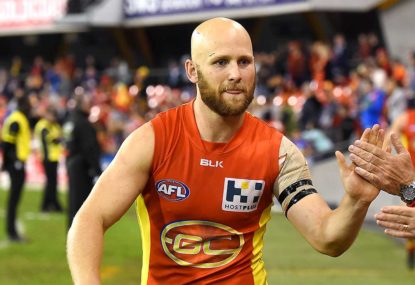The crucial cogs of AFL's Round 7: Which players need to be the difference makers?
We’re taking a look at one player from each team that needs to make a difference this week, starting with the ANZAC Day games.

Talent, desire, intensity and form all play a major part in winning or losing, but one other trait is apparent in all good footy teams: maturity.
Round 2 was a week in which maturity – or teams’ lack thereof – played a significant part.
It all started on Friday night, when a diabolical final six minutes saw the Tigers find another way to kick their fans in the guts.
Leading by 17 points with fewer than six minutes to play (and up by 11 with the clock inside two minutes), Richmond lacked the composure to hold off Collingwood, going down by the slimmest of margins thanks to some poor decision-making in the final minutes and pretty average defending at the death.
To make already terrible matters worse, 25-year-old key defender David Astbury said this after the loss: “I’m sort of not really sure what the coaches really wanted in the last few minutes … it’s something that we’ll have to review.”
It’s hard to know what’s more concerning – that a key defensive cog didn’t know what to do in a tight game, or that a player in his seventh AFL season would admit as much to the press. Mind-boggling stuff.
Things got worse for long-suffering fans on Saturday, when Melbourne arrived at the MCG as the heaviest favourites they’ve been in more than four years, harking back to when they faced the Suns in Gold Coast’s first season.
If ever there has been a club that shouldn’t get ahead of itself, it’s Melbourne, yet the Demons, who haven’t won back-to-back games since 2011, were completely unprepared for a hungry Essendon outfit.
Intensity (the importance of which Cam Rose pointed to last week) should be the easiest thing to start a game with, but it might also be the hardest to rediscover mid-game.
Full credit to the Bombers, but if the Demons came out with the appropriate mindset, they would have comfortably accounted for the ragtag Dons. It was an immaturity master class from Melbourne, and one that should serve as a lesson to every team who face the undermanned but feisty Bombers this year.
Saturday night was a different story as two clubs showed the appropriate mettle on either side of the country.
At Docklands, the Bulldogs weren’t at their best with ball in hand, but their effort never wavered. As a result, they never gave the Saints a sniff on the way to a comprehensive victory.
There was no shortage of good players for the Dogs, but 22-year-old rookie Marcus Adams might have been the best of them. The man mountain from West Perth plays with confidence and composure rarely associated with a two-gamer.
Across the continent, in Adam’s original neck of the woods, the Suns did what so few teams have done in recent times by knocking off Ross Lyon’s Dockers at Subiaco. In doing so, they showed a maturity which fellow expansion club GWS has yet to discover by winning against a decent opponent on the road. Although perhaps it’s too early to say for certain that Fremantle are a decent opponent.
It’s still very early, but the Suns could be ready to live up to the lofty expectations so many had for them 12 months ago.
But perhaps the most impressive performance of the round came at the MCG on Sunday when the Hawks, who were without a handful of their best players (including their best two), dismantled the team widely considered the most likely to end the quest for a historic fourth-straight flag.
It was an astounding reminder of the depth of talent the Hawks possess, but also of the belief and maturity within the club. The defending champs had 166 more disposals, 42 more marks and twice as many inside-50s as West Coast, continually taking away space when they didn’t have the footy and using their slick ball movement to create space when they did.
The 46-point final margin flattered the Eagles.
***
We’ve had it crammed down our throats in recent times just how important it is for teams to score heavily if they want to be serious contenders, so the fact the Swans are the highest-scoring team after two rounds shouldn’t be taken lightly.
Sydney managed 91.2 points a game last season, a respectable but far from intimidating number which ranked sixth in the league. The Swans have already cracked the 130-point mark as many times as they did in 2015.
The midfield looks expectedly powerful, but it’s up front where they are most interesting. Lance Franklin’s abilities are well known and Buddy looks as dangerous as ever early with 36 disposals, ten inside-50s and eight goals so far.
There’s also a new face contributing in youngster Tom Papley, who looks the prototypical small forward. The 176cm rookie has eight tackles and five goals in his first couple of games and has shown a knack for being in the right place at the right time.
Uber-talented teen Isaac Heeney has already had seven shots at goal and should only improve as the season goes on, and ruck duo Kurt Tippett and Callum Sinclair combined for seven goals against the Blues, suggesting whichever one of them isn’t doing ruck duties will be a dangerous target up front.
No reasonable person would expect they Swans to maintain a 130+ scoring average, but it certainly looks like the Swans have the firepower to compete in any shootout in 2016.